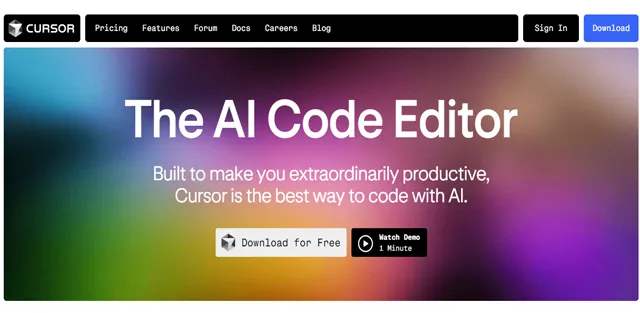
Cursor is an AI code editor. It provides the best answers from your codebase. It predicts your next edit and allows you to breeze through changes. It will enable you to write code using instructions. You can update entire functions or classes with an easy prompt.
- Cursor AI Code Editor Unveils New Features for Smarter Coding
- Cursor Introduces Free GPT-4.1 Access for All Users
- Cursor AI Integrates o3 and Free o4-mini Models for Enhanced Coding
- Cursor Reveals Top AI Models for April 2025
What is Cursor AI?
Cusror AI is an AI-powered code editing platform. It helps to make coding more productive and efficient. Cursor is the brainchild of Anysphere, an applied research lab that creates exceptionally productive human-AI systems.
Key Features
Learn how Cursor's creative features can change your coding experience. With its advanced AI technology and intuitive interface, Cursor simplifies your workflow, reduces tedious tasks, and makes you a more efficient developer. Explore the key features that make Cursor the ultimate coding companion:
Tab: Cursor has a powerful autocomplete that can predict your next edit. Once autocomplete is enabled, it is forever on and will advise edits to your code across numerous lines, assessing your recent changes.
- Code Generation: It can see your recent changes and predict what to do next.
- Multi-Line Edits: Cursor saves your time by suggesting multiple edits at a time.
- Smart Rewrites: Type recklessly, and Cursor will correct your errors.
- Cursor Prediction: Cursor foresees your next cursor position so you can effortlessly navigate your code.
Chat: Chat allows you to talk with an AI that can see your codebase. Use Ctrl+Shift+L or "@" to add distinct code snippets to your context. Press Ctrl+Enter to chat with your entire codebase.
- Codebase Answers: Use Ctrl+Enter or @Codebase to ask queries about your codebase. It will search your codebase to find the appropriate code for your query.
- Reference Your Code: Simply type @ to see a checklist of all the code symbols and files in your folder.
- Use Images: Drag and drop an image into the input box to add visual context in chat.
- Ask The Web: You can get up-to-date information from the internet by typing @Web.
- Instant Apply: You can use the code recommendations from chat in your codebase by hitting the play button.
- Use Documentation: Refer to popular libraries by typing @LibraryName, or create new documents using @Docs → Add new doc.
Ctrl K: Ctrl K allows you to write and edit code with the AI. To edit your code, select some code, click "Edit," and provide instructions to change the code. To generate a new code, type Ctrl K.
- Fast Edits: Write and edit your code with AI.
- Terminal Ctrl K: Use Ctrl K to write terminal commands. It will transform them into the terminal command you require.
- Quick Questions: Click "Quick Question" for immediate answers and clarification.
These features make Cursor an extraordinarily productive tool for developers, simplifying their workflow and improving their coding experience. Head over to Cursor and download Cursor to experience the future of coding.
Use Cases
Discover how Cursor AI can help you gain more productivity as a developer by using these examples of Cursor AI use cases that will change your coding style.
- Code Completion.
- Code Review.
- Debugging.
- Code Optimization.
- Code Explanation.
- Code Generation.
- Code Refactoring.
- Code Search.
- Code Documentation.
- Code Learning.
- Code Collaboration.
- Code Testing.
These are the use cases of Cursor AI, which makes your coding experience a brand-new one.
Positives
- Increased Productivity: It frees programmers from time-consuming work and concentrates on code-intensive problems.
- Improved Code Quality: Automated tools for code review and debugging that improve code quality.
- Enhanced Collaboration: It allows seamless team collaboration and knowledge sharing.
- Faster Learning: It provides AI-powered code explanations and tutorials for rapid skill acquisition.
- Streamlined Workflow: It assists with AI-driven code completion, refactoring, and optimization.
- Error Reduction: AI-assisted debugging and testing for fewer errors.
- Improved Code Readability: It has AI-generated code documentation and comments improve code readability.
- Time Savings: Reduced time spent on mundane tasks, allowing for more creative work.
- Privacy & Security: Cursor AI is SOC 2 certified.
Negatives
- Dependence on AI: Over-reliance on AI may hinder your coding skills.
- Integration Challenges: Probable difficulties integrating Cursor AI with existing tools and workflows.
- Cost: Subscription fees for Cursor AI may be a financial burden.
How much does it cost?
Cursor AI offers a free Hobby plan that includes a Pro-two-week trial. The Pro plan costs $20 per month. The Business plan costs $40 per user per month.
How to use Cursor AI?
Here's a step-by-step guide on how to use Cursor AI:
Step 1: Download and install the Cursor AI plugin or extension.
Step 2: Activate Privacy Mode to keep your code secure and stored locally.
Step 3: Start coding in your editor or IDE with Cursor AI-enabled.
Step 4: Select a code snippet or ask a question in natural language.
Step 5: Request a code review, and Cursor AI analyzes your code for errors, improvements, and best practices.
Step 6: Invite team members to collaborate on code projects.
Step 7: Explore Cursor AI's learning resources, such as tutorials, documentation, and code examples.
Shortcuts:
- Ctrl+K (Windows/Linux) or Cmd+K (Mac): Open Cursor AI panel
- Ctrl+Shift+L (Windows/Linux) or Cmd+Shift+L (Mac): Select code and ask a question
- Ctrl+Shift+R (Windows/Linux) or Cmd+Shift+R (Mac): Request code review
With the help of these steps and the shortcuts shown above, you can empower your coding experience with Cursor AI.
Useful Links
 Cursor AI pricing 2025: Plans, Features, and Subscription Costs Explained
Cursor AI pricing 2025: Plans, Features, and Subscription Costs Explained
- Hobby
- Free
- Pro
- $20/month
- Business
- $40/User/Month
 Cursor AI Reviews & Ratings: See What Users and Experts Are Saying
Cursor AI Reviews & Ratings: See What Users and Experts Are Saying
 Cursor AI FAQ: Learn How to Use It, Troubleshoot Issues, and More
Cursor AI FAQ: Learn How to Use It, Troubleshoot Issues, and More
Yes, Cursor AI allows you to edit code using natural language instructions.
Yes, Cursor AI allows you to import your existing extensions, themes, and keybindings.
Yes, Cursor AI allows you to bring your API key.
You can use your API key or their hosted version for the utmost experience.
The alternatives for Cursor AI are GitHub Copilot, TabNine, Kite, Codeium, Codex, DeepCode, CodeBERT, etc.
 Summary
Summary
Cursor has become the most acceptable way to code with AI, fuelled by an array of custom and state-of-the-art models, enjoyable editing, and petabyte-scale infrastructure. It has raised $60M from Jeff Dean, Andreessen Horowitz, Noam Brown, John Schulman, and the founders of GitHub and Stripe.

















